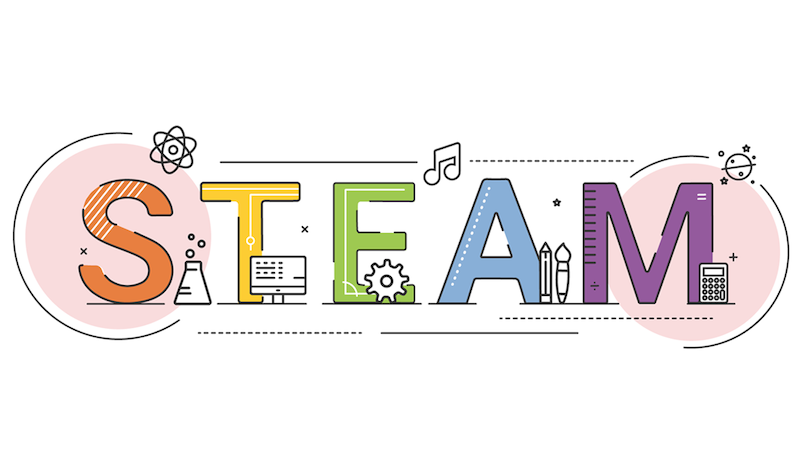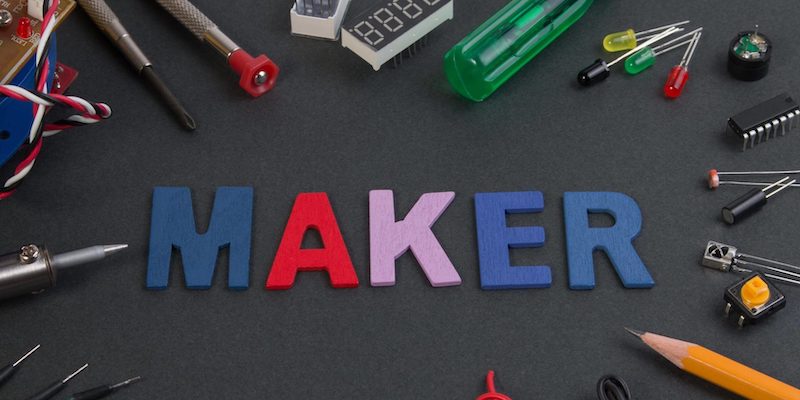In today’s world of education, much as been made about the shift from traditional teaching and learning to a STEM-focused approach. As STEM education has developed over the last few years, now there are even more ways for teachers to deliver an innovative educational experience for their students. STEM education has been broken down into various focuses, including robotics, coding, 3D printing, and more, but there have also been letters added to this now almost ubiquitous acronym along the way as well. Not everyone just sticks to STEM anymore as the emergence of STEAM, STREAM, STREAMe, and Maker Education have also evolved into reliable ways of teaching today’s kids. This week, we’re getting more in-depth with each of these and discussing what makes them appealing, successful, and anything else you might be wondering (like what all these letters stand for)!
STEM
You probably know that STEM refers to science, technology, engineering, and math. STEM learning is sweeping the world at all levels of education and for good reason. It provides students with authentic opportunities to learn and develop real-world skills through hands-on learning experiences. Some of these skills include things like coding, engineering, and mastering electronics, but also others like problem solving and collaboration. STEM jobs, especially those in the computer science field, make up a considerable part of the current economy and too many of them remain unfilled due to a shortage of skilled workers. Despite the promise of higher-than-average salaries and seemingly strong job security, there continues to be a lack of skilled computer science graduates. This also leads thinking that there should be a greater focus on the early introduction of STEM.
The challenges students face today are unlike those that were ever faced by students in previous generations. Though they probably do not realize it, kids will be competing with people all around the world for jobs in the future—a huge difference compared to the fact that they would previously only compete with people in their immediate area. That has led to a mindset shift that focuses on some innovative ways of looking at learning. It’s no longer vital for teachers to make sure every student passes every class. They’re more focused on helping them learn to thrive in a global, tech-centered workforce. This is why it’s imperative to give today’s youth a strong STEM education. Aside from the fact that the fastest-growing industries require STEM skills, STEM education also teaches kids to think critically and solve real-life problems.
There are many career options for today’s students, but almost all will require some amount of STEM skills. Educators have the ability to create powerful STEM learning opportunities for their students. This could be key to developing the next generation of thinkers and creators through the constant practice of STEM methods. If teachers can get some support and unlock regular time in STEM labs for students, start to create digital learning communities, or expose them to a bit more computer science every year, that’s a solid start. As these initiatives start to become more ubiquitous, STEM development should hopefully really begin to take off. So much is being made about STEM education because of the opportunities it holds and the necessity with which it’s being relied upon. Before adding in any other letters to STEM, we hope educators in every school can start with the basics and get students involved!
STEAM
As we discussed, STEM is an educational approach that focuses on hands-on experiences in science, technology, engineering, and math. When teachers add in the A to make it STEAM, they’re also setting their students up for success. The A, as you may know, stands for Art and art—whether in the traditional or digital sense—helps foster student creativity and inspires them to try new things. Adding the A to STEM is something that many educators have discovered takes student creativity to a new level. Since art involves so much creativity, it’s natural that students start thinking more creatively, which is good for a number of reasons. One of those reasons is that STEM-based problem solving requires a large amount of creativity in both the present and the future. Another is that an artistic approach to problem solving can benefit students both in and out of the classroom.
Adding a new focus on the arts allows students to learn the skills essential for the 21st century in an entirely new way. This is a valuable thing to know since there are plenty of students who get overwhelmed with the technical focus in STEM learning and become much more comfortable when they are able to lean more on their artistic strengths and creativity in STEAM learning. One of the main reasons STEAM education has become so important is that it allows educators to blend classroom subjects and cover more content rather than keeping math separate from English and social studies separate from science, for example. This allows students to draw on their creative thinking throughout the day and also helps them begin to realize that the world is not as segregated as their older lessons would seem to suggest. They need creative thinking, which is rooted in STEAM education, in just about every aspect of the school day—as they will in their future challenges as well.
For educators, teaching STEAM is a great opportunity because it can be taught in so many ways. Both teachers and students are able to use their imaginations to create learning experiences that focus on STEAM skills and bring student creativity to life. In an engineering class, for example, the students might not be too interested in learning more about art. When they’re given the opportunity to draw out a design, however, they’re likely to realize the connection between creatively thinking like an artist and intricately designing like an engineer. On the other hand, coding—one of today’s most important skills—can be a large part of arts education. Students can use code to create graphic design projects or video projects while still maintaining their focus on creative expression. See, there is a reason why STEAM education is such a popular and useful way of teaching in the 21st century and it should continue to be a tried and true approach to fostering student creativity and preparing them for the real world.

STREAM
Moving on through the alphabet, we’ve now added one more letter to our original acronym of STEM. The ‘R’ stands for robotics. Well, it stands for robotics if you ask us. Depending on who it is you ask, though, it could stand for reading or religion. Since we’re of a STEM and technology mindset, however, we’re going to stick to robotics. Robotics is such a large part of STEM learning and it is certainly understandable that educators have begun to characterize it as its own educational category. Learning with robotics tools allows kids to think like computer scientists, problem solve independently or collaboratively, practice coding, and even experience engineering all in their classrooms. Perhaps most importantly, STREAM empowers educators to create cross-curricular opportunities for their students by incorporating robotics into subjects like English, reading, history, and more!
STREAM education is certainly not as prominent as STEM or STEAM, but it is definitely up and coming. With a STREAM approach, teachers are able to create classrooms with a multi-discipline focus and unlock authentic learning experiences that cover multiple key topics. Some of the best ways to work on implementing STREAM effectively are for teachers to do some research online and collaborate with their peers at school. There are so many helpful resources floating around the Web, particularly on Twitter, and, well, brainstorming with colleagues often leads to genius ideas as well. These resources are useful because they help teachers realize that they no longer teach in a single classroom. Rather, they are responsible for tying so many concepts and experiences together so that kids are able to seamlessly transfer what they learn from subject to subject, ultimately preparing them to take what they learn and run with it when the real world throws so many different challenges at them.
To effectively teach STREAM, teachers should look for natural correlations between concepts taught in different school subjects. One example is 3D shapes. Obviously, this is a math concept, but it can also relate to science since so many natural landforms are three dimensional. It can also relate to technology because kids can use new technology to design their own 3D structures. And, it can related to engineering because they may have to envision the shape of a structure before they design it. Believe it or not, robotics relates to each of these areas, often allowing students to create their own programs to control everything from the features and shapes of their robot to the way it moves. Using robotics to bring STEAM teaching to another level is something that can be done in almost any grade and on almost any budget. Check out our store for pages worth of cool robotics tools teachers and students can use to create amazing STREAM learning opportunities!
STEAMe
Something seems different about this acronym. Ah, that's it. One of the letters is lower case. We’re not really sure why the second ‘E’ is not capitalized, but what we can tell you is that it stands for entrepreneurship. In today’s (and likely the future’s) gig economy, entrepreneurship is a very useful skill for students to possess. Luckily for teachers, it’s also something that can be incorporated into everyday instruction pretty easily. Educational leaders speak of the importance of teaching every subject with one eye on the content matter and the other on tying it to career readiness. That ties in with the cross-curricular approach we discussed in the previous section in which just about every subject can be connected with STEM or STEAM to give students real-world experiences and real-world advantages. We have little remaining doubt that the futures today’s students will take on will include STEM (or STEAM) in one form or another and teaching them an entrepreneurial mindset can help take them further.
The best way to help students develop entrepreneurial skills is to give them relevant career experience before they graduate. Especially in high school, it’s becoming quite common for students to take part in job showing, apprenticeships, and internships—much more so than it would have been done in past years. In doing this, guidance counselors also play a role in helping students design their classes, course work, and job experiences with a focus on what they want to accomplish both now and in the future. By helping students discover their best skills and most passionate interests, educators can often help their entrepreneurial instincts take over. Also, this is not something that needs to stay between students and their guidance counselors. Since it is the 21st century after all, aligning future career plans with the curricular content discussed throughout the day is certainly something that is beneficial. Keying in on what students want to do in the future is the foundation of this approach and that is something that should be kept in mind throughout the process.
In traditional school subjects, students learn about things like conflict in an English class, significant events in a history class, and so on. Today, it is useful for educators to help students develop an entrepreneurial mindset by trying to relate events from the past to what they are experiencing today. If a character in a story or play that is a few hundred years old, for example, was facing the same dilemma in a modern time, how would they solve it using the technology and resources that are available to us today? It’s this kind of outside-the-box thinking that’s helpful in developing entrepreneurial skills in students. Entrepreneurs tend to realize a problem being faced by people in the modern world and work to develop an efficient solution to that problem. Relating past events to the current world students live in could prove to be an effective way to bring STEAMe into more classes and help them work on building that entrepreneurial mindset.

MakerEd
No, MakerEd is not an acronym and does not sound like the other sections of STEM, but it is becoming a huge part of 21st century learning. Maker Education is the practice of helping illuminate key STEM concepts to children through tinkering, breaking, fixing, and building things—anything. Oftentimes, it is associated with the work that is done in school, public, or library makerspaces, where children are free from the pressures of classwork and grades and can really let their creativity fly. Makerspaces and MakerEd definitely started more as an afterschool opportunity, but have grown from a fad into more of an accepted way to teach STEM and invention skills to students. As more and more teachers turn to maker education to embrace the creative demands put forth by the 21st century world, students are reaping the benefits and using these hands-on learning opportunities—whether they include technology or not—to start to fully understand what it means to be creative.
Maker Education is very closely related to project-based learning, during which students are constantly active and learning with their hands rather than just sitting in a classroom and soaking in material. In fact, MakerEd is almost completely reliant on these hands-on experiences and the creative solving of problems by students. The best maker learning experiences involve students taking a project from concept to reality and using it to solve a real-world problem while also demonstrating authentic learning. Most importantly, maker education matters so much in modern educational environments because it allows teachers to create and facilitate so many hands-on projects for all areas of their curriculum. This can include anything from kids learning the basics of circuits to creating a 3D printed village that runs on renewable energy. Plus, the flexibility that MakerEd projects naturally possess helps teachers meet standards and meet the needs of every student in the class.
One of the biggest advantages of maker education is that it creates a shift away from teacher-led and curriculum-dictated learning. This leads to much deeper levels of inspiration for students, which, in turn, help create increased engagement and enjoyment. MakerEd opens the door for new methods of teaching and helps teachers include a range of objectives in a single project. Among the benefits it provides for students include connected learning across content areas, encouraging critical thinking and problem solving, enabling learning by doing, helping kids pick up STEAM concepts, and it’s generally a lot more fun. Like the other sections of STEM, MakerEd can be used in just about any subject at just about any time. Students could design and create 3D models of anything they are learning about just to name one example. However you slice it, maker learning and all the umbrellas of STEM education are being used to help inspire students and steer them toward the innovation skills they’ll need for the future.
For the latest EdTech, STEM, and 21st century education news, follow us on Twitter and Instagram. Like us on Facebook, too, or sign up for our newsletter for our latest product announcements and offerings. If you have an idea for an Eduporium Weekly theme, send us a message on social media or comment below.



